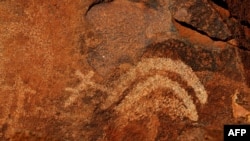Australia is investigating claims by First Nations groups that mining and manufacturing industries are threatening significant cultural sites.
Indigenous settlement of Australia dates back an estimated 65,000 years.
This vast history is documented in ancient songs, stories, dance and art, but development threatens part of the culture.
The federal government has appointed an independent investigator to gauge the threat of industrial expansion to 40,000-year-old Indigenous rock art in Western Australia.
It is a controversy that has been brewing for months.
In August, the government rejected Aboriginal groups’ application for a 60-day moratorium to stop Perdaman, the multinational operator of a fertilizer plant, from relocating sacred rock art. However, authorities in Canberra have now agreed to appoint an expert to assess whether the art is at risk, and whether it must be protected by a ministerial declaration.
The site at the remote Burrup Peninsula, 1,500 kilometers north of Perth, has been recommended for a United Nation’s World Heritage listing. It is considered to be one of the world's most significant collections of ancient rock carvings.
The region has more than a million petroglyphs, or art carved, scratched or scoured from rock, spread over 37,000 hectares. First Nations elders have said the depictions are all connected, and that moving some of the carvings would damage their spiritual connection to the sites that tell stories of creation.
Indigenous leader Raelene Cooper told the Australian Broadcasting Corp. that sacred sites need to be shielded from industrial development.
“It is appalling that at this day and age we are still, as First Nations people, being told to sit in the back sit and that ain’t [is not] me,” Cooper said. “If there is anything that I could, I guess, advise for all of my country mob all over this continent we have a right and we have a story and we have a history here and our government needs to start acknowledging it.”
The independent investigation could take months. However, Perdaman already has official permission to start work on its Burrup Peninsula project. The fertilizer manufacturer has consulted with local Indigenous communities about its plans to relocate some rock carvings. It has not yet commented publicly on its operations.
The Western Australian government supports the development, saying it has the appropriate environmental and heritage approvals.
The state government has also set up an extensive program to monitor the impact of emissions from local gas production on ancient petroglyphs in the area.
A parliamentary inquiry into the destruction of the Juukan Gorge rock shelters by resources giant Rio Tinto in 2020 recommended new laws to protect thousands of sacred sites across Australia.
However, some legal experts believe not enough has been done and that economic interests continue to be placed ahead of First Nations culture.
Minister for Indigenous Australians Linda Burney said in July the new Labor government would implement new cultural heritage legislation, but a timeframe has yet to be set.
